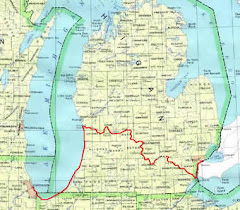Here is something I pulled off the Internet which is very descriptive of what the Krugers would have seen when they got to their destination after struggling upstream on the Clearwater River (From "Great Canadian Rivers").
"At an overgrown landing in a small cove not far from the Saskatchewan-Alberta border, Clearwater River runners will encounter a path leading steeply up to a forested ridge. A short hike into the woodland above reveals an historic trail. Worn down by the feet of countless aboriginal hunters, voyageurs, pack horses and moose, and deeply rutted by the the wheels of fur-laden ox carts, the trail extends 20 kilometers over a pine and spruce-covered sandy ridge.
The legendary Methye Portage spans a plateau separating the Clearwater River from Lac la Loche and marks a continental divide between the Churchill and Athabaska-Mackenzie River systems. (the Churchill flows into Hudson Bay). In 1778 this short stretch of land became the one of the busiest hubs of the 19th Century fur trade, opening up the rich fur country of the North West to the merchants of Montreal."
Not the Kruger expedition, but a good reality check on what it takes to make a portage. (From the ottertooth.com Che Mun page.)
Valerie describes their crossing of the portage: "We arrived at the trail in the early afternoon and shouldered our packs to begin the long walk. We always take our packs first because when we carry the canoes on our heads and shoulders our visibility decreases. We take the first load to familiarze ourselves with the trail. The path gained 800 feet of elevation in the first four miles so there was plenty of huffing and puffing on our parts. But it was beautiful, walking through the woods on a trail that had so much colorful history. I tried tio imagine the voyageurs carrying their packs and stopping every 15 minutes for a "pose" which means rest period. They could set down their packs and smoke a pipe. To the voyageurs the portages weren't measured in miles but instead were described as being "three or four pipes".
Valerie goes on: "It was getting dark on August 10, 1986, as we arrived at Rendezvous Lake, a beautiful spot at the four-mile point of Methye Portage. There, with the sounds of loons and the magic spell of the Northern Lights, we made our camp." They had eight more miles to go.
Here is something I didn't know. They had been carrying a set of wheels. Valerie again:
"Ralph Freese at the Chicagoland Canoe Base had sent us a cart to use on those portages that were flat enough and wide enough to accomodate the wheels. For the first time, we tried them out, making a Sea Wind 'sandwich' of our canoes, stacked on top of each other, with me pulling and Verlen pushing and steering from the stern. We made those eight miles in one trip! And averaging one mile per hour!"
Verlen and his partners had crossed this portage in the other direction in 1971 and 1981. I read his accounts of both crossings. He complained a lot about mosquitos.
After the portage Verlen and Valerie were heading downstream for the first time since they started the Two Continent Expedition. Lac la Loche connects the portage with the Methye River to the south. The community of La Loche on the eastshore was undoubtedly visited by the Krugers on the way.
Valerie: "The Methye River has a seies of fast waters and it was quite a switch, feeling the canoe pulled along and floating pell mell down a whitewater shoot! The rapids on the Methye were small compare to the Churchill River Rapids still ahead of us."
Next: The Churchill River.



No comments:
Post a Comment